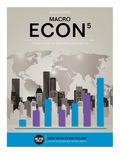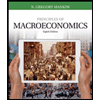
Concept explainers
Sub-part
A
The amount that the bank should lend, assuming that it holds no
Sub-part
A
Explanation of Solution
a. If Bank A wishes to hold no excess reserves form the deposit of $1,000, then the deposits would go up by $1,000 in liabilities. In the assets, the required reserves increase by $100 (10%
| Bank A's | |||
| Assets | Liabilities | ||
| Reserves | $100 | Deposits | $1,000 |
| Loans | $900 | ||
Introduction:
The Federal Reserve and banking system are responsible for the creation of money in the economy. The first step of this money creation process starts when the Federal Reserve injects money in the economy by buying bonds. This money is stored in a bank. Then, the bank would keep the required reserves with themselves, and lent the remaining excess reserves. These excess reserves will then be stored with some other bank and the other bank would also keep the required reserve and make a loan for the remaining amount. These excess reserves keep flowing in the economy, thus, creating money at every stage. A bank’s balance sheet has the deposit account and capital account on the liabilities side, and cash reserves, required reserves, loans, and securities are on the asset side of the bank’s balance sheet that are affected by the money creation process.
Sub-Part
B
The changes in the balance sheet of bank B, when maximum amount is lent..
Sub-Part
B
Explanation of Solution
The Bank B receives a deposit of $900 which it plans to lend keeping the required reserve. Thus, it will have similar effects as in part A. Bank B’s deposits increase by $900, and its reserves and loans increase by $90 (10% required reserve of $900) and $810 respectively.
| Bank B's balance sheet | |||
| Assets | Liabilities | ||
| Reserves | $90 | Deposits | $900 |
| Loans | $810 | ||
Introduction:
The Federal Reserve and banking system are responsible for the creation of money in the economy. The first step of this money creation process starts when the Federal Reserve injects money in the economy by buying bonds. This money is stored in a bank. Then, the bank would keep the required reserves with themselves, and lent the remaining excess reserves. These excess reserves will then be stored with some other bank and the other bank would also keep the required reserve and make a loan for the remaining amount. These excess reserves keep flowing in the economy, thus, creating money at every stage. A bank’s balance sheet has the deposit account and capital account on the liabilities side, and cash reserves, required reserves, loans, and securities are on the asset side of the bank’s balance sheet that are affected by the money creation process.
Sub-Part
C
The same process for banks C, D and E.
Sub-Part
C
Explanation of Solution
b. Similar, effects will take place in Banks C, D, and E. Each of their deposit will increase, and, holding 10% of reserves, their loans will increase too.
| Bank C's balance sheet | |||
| Assets | Liabilities | ||
| Reserves | $81 | Deposits | $810 |
| Loans | $729 | ||
| Bank D's balance sheet | |||
| Assets | Liabilities | ||
| Reserves | $72.90 | Deposits | $729.00 |
| Loans | $656.10 | ||
| Bank E's balance sheet | |||
| Assets | Liabilities | ||
| Reserves | $65.61 | Deposits | $656.10 |
| Loans | $590.49 | ||
Introduction:
The Federal Reserve and banking system are responsible for the creation of money in the economy. The first step of this money creation process starts when the Federal Reserve injects money in the economy by buying bonds. This money is stored in a bank. Then, the bank would keep the required reserves with themselves, and lent the remaining excess reserves. These excess reserves will then be stored with some other bank and the other bank would also keep the required reserve and make a loan for the remaining amount. These excess reserves keep flowing in the economy, thus, creating money at every stage. A bank’s balance sheet has the deposit account and capital account on the liabilities side, and cash reserves, required reserves, loans, and securities are on the asset side of the bank’s balance sheet that are affected by the money creation process.
Sub-Part
D
The total change in the money supply as a consequence of $1000 initial deposit.
Sub-Part
D
Explanation of Solution
The change in the money supply takes place when the excess reserves are lent out by the first bank. The formula to calculate the change in money supply is change in fresh reserves times the reciprocal of the reserve ratio. Thus,
Introduction:
The Federal Reserve and banking system are responsible for the creation of money in the economy. The first step of this money creation process starts when the Federal Reserve injects money in the economy by buying bonds. This money is stored in a bank. Then, the bank would keep the required reserves with themselves, and lent the remaining excess reserves. These excess reserves will then be stored with some other bank and the other bank would also keep the required reserve and make a loan for the remaining amount. These excess reserves keep flowing in the economy, thus, creating money at every stage. A bank’s balance sheet has the deposit account and capital account on the liabilities side, and cash reserves, required reserves, loans, and securities are on the asset side of the bank’s balance sheet that are affected by the money creation process.
Sub-Part
E
The effect on the total change in the money supply with holding the level of excess reserves.
Sub-Part
E
Explanation of Solution
If each of the banks plans to hold 5% excess reserves, then the money supply will reduce by 5%. Thus, the reserve ratio increases from 10% to 15%. With this effect, the change in money supply will be as follows:
Introduction:
The Federal Reserve and banking system are responsible for the creation of money in the economy. The first step of this money creation process starts when the Federal Reserve injects money in the economy by buying bonds. This money is stored in a bank. Then, the bank would keep the required reserves with themselves, and lent the remaining excess reserves. These excess reserves will then be stored with some other bank and the other bank would also keep the required reserve and make a loan for the remaining amount. These excess reserves keep flowing in the economy, thus, creating money at every stage. A bank’s balance sheet has the deposit account and capital account on the liabilities side, and cash reserves, required reserves, loans, and securities are on the asset side of the bank’s balance sheet that are affected by the money creation process.
Want to see more full solutions like this?
- a. How much does aggregate demand need to change to restore the economy to its long-run equilibrium? $ billion b. If the MPC is 0.6, how much does government purchases need to change to shift aggregate demand by the amount you found in part a? $ billion Suppose instead that the MPC is 0.95. c. How much does aggregate demand and government purchases need to change to restore the economy to its long-run equilibrium? Aggregate demand needs to change by $ billion and government purchases need to change by $ billion.arrow_forwardPrice P 1. Explain the distinction between outputs and outcomes in social service delivery 2. Discuss the Rawlsian theory of justice and briefly comment on its relevance to the political economy of South Africa. [2] [7] 3. Redistributive expenditure can take the form of direct cash transfers (grants) and/or in- kind subsidies. With references to the graphs below, discuss the merits of these two transfer types in the presence and absence of a positive externality. [6] 9 Quantity (a) P, MC, MB MSB MPB+MEB MPB P-MC MEB Quantity (6) MCarrow_forwardDon't use ai to answer I will report you answerarrow_forward
- If 17 Ps are needed and no on-hand inventory exists fot any of thr items, how many Cs will be needed?arrow_forwardExercise 5Consider the demand and supply functions for the notebooks market.QD=10,000−100pQS=900pa. Make a table with the corresponding supply and demand schedule.b. Draw the corresponding graph.c. Is it possible to find the price and quantity of equilibrium with the graph method? d. Find the price and quantity of equilibrium by solving the system of equations.arrow_forward1. Consider the market supply curve which passes through the intercept and from which the marketequilibrium data is known, this is, the price and quantity of equilibrium PE=50 and QE=2000.a. Considering those two points, find the equation of the supply. b. Draw a graph for this equation. 2. Considering the previous supply line, determine if the following demand function corresponds to themarket demand equilibrium stated above. QD=.3000-2p.arrow_forward
- Supply and demand functions show different relationship between the price and quantities suppliedand demanded. Explain the reason for that relation and provide one reference with your answer.arrow_forward13:53 APP 簸洛瞭對照 Vo 56 5G 48% 48% atheva.cc/index/index/index.html The Most Trusted, Secure, Fast, Reliable Cryptocurrency Exchange Get started with the easiest and most secure platform to buy, sell, trade, and earn Cryptocurrency Balance:0.00 Recharge Withdraw Message About us BTC/USDT ETH/USDT EOS/USDT 83241.12 1841.50 83241.12 +1.00% +0.08% +1.00% Operating norms Symbol Latest price 24hFluctuation B BTC/USDT 83241.12 +1.00% ETH/USDT 1841.50 +0.08% B BTC/USD illı 83241.12 +1.00% Home Markets Trade Record Mine О <arrow_forwardThe production function of a firm is described by the following equation Q=10,000L-3L2 where Lstands for the units of labour.a) Draw a graph for this equation. Use the quantity produced in the y-axis, and the units of labour inthe x-axis. b) What is the maximum production level? c) How many units of labour are needed at that point?arrow_forward
 Essentials of Economics (MindTap Course List)EconomicsISBN:9781337091992Author:N. Gregory MankiwPublisher:Cengage Learning
Essentials of Economics (MindTap Course List)EconomicsISBN:9781337091992Author:N. Gregory MankiwPublisher:Cengage Learning Principles of Economics (MindTap Course List)EconomicsISBN:9781305585126Author:N. Gregory MankiwPublisher:Cengage Learning
Principles of Economics (MindTap Course List)EconomicsISBN:9781305585126Author:N. Gregory MankiwPublisher:Cengage Learning Principles of Macroeconomics (MindTap Course List)EconomicsISBN:9781285165912Author:N. Gregory MankiwPublisher:Cengage Learning
Principles of Macroeconomics (MindTap Course List)EconomicsISBN:9781285165912Author:N. Gregory MankiwPublisher:Cengage Learning Brief Principles of Macroeconomics (MindTap Cours...EconomicsISBN:9781337091985Author:N. Gregory MankiwPublisher:Cengage Learning
Brief Principles of Macroeconomics (MindTap Cours...EconomicsISBN:9781337091985Author:N. Gregory MankiwPublisher:Cengage Learning Principles of Economics, 7th Edition (MindTap Cou...EconomicsISBN:9781285165875Author:N. Gregory MankiwPublisher:Cengage Learning
Principles of Economics, 7th Edition (MindTap Cou...EconomicsISBN:9781285165875Author:N. Gregory MankiwPublisher:Cengage Learning Principles of Macroeconomics (MindTap Course List)EconomicsISBN:9781305971509Author:N. Gregory MankiwPublisher:Cengage Learning
Principles of Macroeconomics (MindTap Course List)EconomicsISBN:9781305971509Author:N. Gregory MankiwPublisher:Cengage Learning





